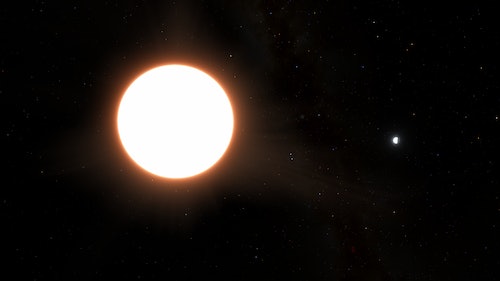An exoplanet with clouds of glass and metal reflects 80% of the starlight that hits it. A European Space Agency Satellite just spotted a mirror made of clouds on a blazing-hot exoplanet. A layer of glass clouds floats above a layer of titanium clouds in exoplanet LTT9779b’s atmosphere, creating a natural mirror that reflects 80 percent of the starlight that reaches it.
In our own Solar System, even reflects just 75 percent of the sunlight it catches. But the fact that it’s a mirror world isn’t even the strangest thing about LTT9779b, a world about the size of Neptune but nearly twice as massive that orbits its star once every 19 hours. “Imagine a burning world, close to its star, with heavy clouds of metals floating aloft, raining down titanium droplets,” says Diego Portales University astronomer James Jenkins, a co-author on the , in a recent statement.
An artist’s concept of LTT9779b orbiting its host star. Astronomer Sergio Hoyer, of the Marseille Astrophysics Laboratory, used ESA’s CHaracterising ExOPlanet Satellite (CHEOPS) to watch the planet . That’s the only way astronomers can catch a glimpse of the daylit side of a planet like LTT9779b, which is tidally locked so the same side of the planet always faces the star.
When an exoplanet passes in front of its parent star, the star seems to dim a tiny bit where the planet blocks its light. The opposite thing happened when LTT9779b’s dayside briefly faced Earth: the star seemed to get brighter because the planet’s mirror-like atmosphere reflected so much light toward Earth. And the spectrum of that light revealed what the reflective clouds were made of: the upper layer of clouds are mostly silicate, a mix of silicon and oxygen, which we often encounter in sand and glass.
Meanwhile, the lower layer of clouds are titanate, a mix of titanium and oxygen. The result is a mirror made of clouds, and it helps LTT9779b exploit a couple of clever physics loopholes in order to maintain its weird existence. At more than 3,600 degrees Fahrenheit, the daytime side of LTT9779b is too hot for clouds to form.
Clouds usually happen when little droplets of liquid start to condense out of a gas, which means the temperature has to be below the boiling point of whatever the gas is made of. It’s hot enough to completely vaporize even titanium and glass on LTT9779b. But there’s a catch.
When the atmosphere is too full of vapor — like having 110 percent humidity here on Earth — it can start condensing into clouds even if it’s technically too hot. That’s exactly what’s happening on LTT9779b, according to Astronomer Vivien Parmentier, of the Observatory of Cote d’Ivore, a co-author of the recent study, who described the phenomenon in a statement. LTT9779b’s cloudy mirror also helps keep the planet from being even hotter.
Because the exoplanet is perilously close to its star and also relatively small , which is huge compared to Earth but not compared to a gas giant a few times the size of Jupiter), astronomers wouldn’t normally expect it to have an atmosphere at all. Stellar winds and radiation should have stripped the atmosphere away long ago, leaving behind a much smaller ball of bare rock. The mirrors floating in LTT9779b’s atmosphere, however, help keep the planet relatively cool by reflecting light back to the star (like a very literal space blanket).
Titanium is also heavy enough to resist getting pushed around by stellar winds, unlike lighter atmospheres made of helium and hydrogen. Astronomers first spotted LTT9779b with NASA’s Transiting Exoplanet Survey Satellite (TESS) in 2020. Hoyer and his colleagues say the mirror world might be a good future target for Hubble and the James Webb Space Telescope, which can measure the light from the exoplanet’s shiny atmosphere in other wavelengths of light and reveal more details about this strange mirror world.
.
From: inverse
URL: https://www.inverse.com/science/astronomers-discover-a-mirror-planet-around-a-distant-star



